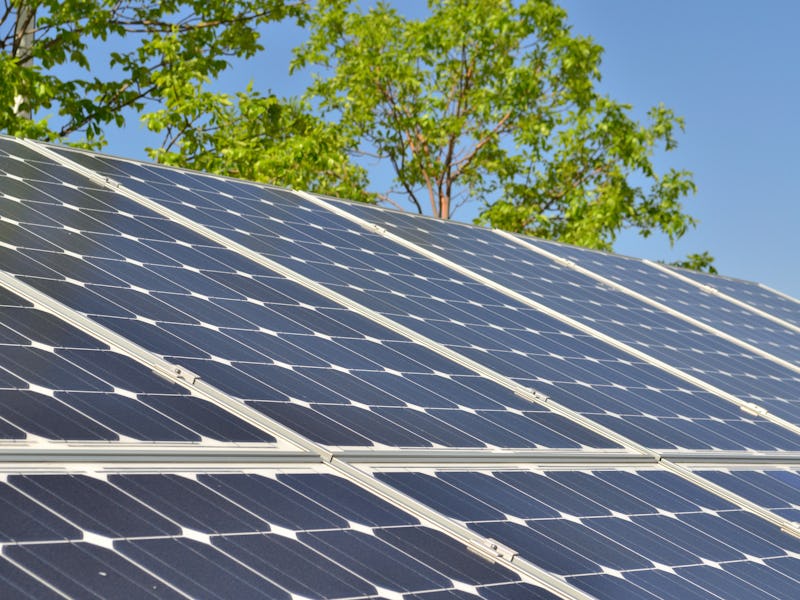An outdated idea about solar panels has been slowing advancement, study shows
It's time for new, short-term solar panels to shine

Whether they are neatly arranged in fields, or covering the roof of a house in the suburbs, solar panels have become a common sight worldwide.
But a new study published in Joule says outdated wisdom about the lifespan of these panels has been crippling the advancement of these technologies for years.
“When you talk to people in the solar field, they say any new solar panel has to last 25 years,” Joel Jean, CEO of startup company Swift Solar, says in a statement. “If someone comes up with a new technology with a ten-year lifetime, no one is going to look at it. That’s considered common knowledge in the field, and it’s kind of crippling.”
Traditionally, solar panels have been laboriously installed and operated for at least 25 years, or until signs of failure appear, before being replaced along with the entire framework of the system. Despite more environmentally efficient models being proposed, the industry standard pushed back against anything that could be expected to have less than 25 years of longevity.
The authors write that this ideology made sense in the past when the panels themselves were a significant part of the cost, but as the price of solar technology has been driven down that isn’t necessarily the case today.
And now, through their analysis of three different types of solar panel installations, including a residential, commercial, and utility-scale system, the team found that replacing the panels of these systems after 10-15 years, instead of the traditional 25 provided the same the environmental benefits while actually lowering costs.
Solar panels have been traditionally replaced every 25 years, but a new study found it could be much sooner
“Most of the technology is in the panel, but most of the cost is in the system,” Jean says.
In recent years, the price of solar panel technology has been driven down, but the cost of labor and installation hasn’t. As the framework technologies go out of date within a 25-year period, individuals and companies are facing larger costs when they are required replace both the framework system and the panels themselves every 25-30 years in order to install entirely new systems.
Replacing panels more often with newer and more advanced models would allow cross-compatibility
In contrast, the authors write that replacing panels more often with newer and more advanced models would allow cross-compatibility between the panels and the system, allowing the framework itself to remain the same while new panels are popped on and off.
And, more important that personally pocketing a little extra cash, the authors write that driving down the overall expenses of solar panels will be an essential way the industry is able to meet efficiency goals laid out by organizations like the International Energy Agency and work to effectively mitigate effects of climate change.
"This work highlights an opportunity for emerging high-potential solar photovoltaic (PV) technologies to enter the market sooner than expected. PV modules are conventionally required to operate with minimal degradation for 25 years or more. We evaluate a PV system operating strategy that anticipates periodic replacement of all modules. Shorter-lived modules are later replaced with higher-performing, longer-lived modules, leading in many cases to a competitive levelized cost of electricity (LCOE)."
“The new analysis may now open the door for some of the promising newer technologies to be deployed at sufficient scale to build up similar levels of experience and improvement over time and to make an impact on climate change earlier than they could without module replacement,” Jean said in the press release.
Abstract:
Today’s approach to deploying solar photovoltaics (PVs) implicitly assumes that module technology is fixed. Solar panels are installed and expected to operate for the system life of 30 years or more. However, many PV technologies are improving rapidly along several dimensions, including cost, power conversion efficiency, and reliability. Periodic module replacement or planned repowering takes advantage of this technological improvement and counteracts predictable degradation. Here, we show that a module replacement strategy allows a competitive levelized cost of electricity to be achieved with an initial module lifetime of less than 15 years, assuming backward compatibility with the original system design. We also assess the life-cycle environmental impacts of module replacement and find that all commercial PV technologies offer benefits in the majority of impact categories, regardless of the replacement strategy, compared to today’s electric generation mix. Module replacement can thus accelerate the market introduction and decarbonization impact of emerging PV technologies that have achieved a competitive module efficiency (R20%), cost (%$0.30/W), and lifetime (R10 years) and have the potential to improve Q2 further on all three metrics but lack decades-long field deployment experience.